New England (Jump to Section)
- The New England economy has cooled in 2025 as a combination of reduced tourist inflows, federal research funding cuts, and trade uncertainty has weighed on the region. We expect real GDP growth to ease to 1.5% this year amid this backdrop. Job and labor force growth have remained stagnant, allowing the unemployment rate to plateau at its highest level since mid-2016 outside of the pandemic. We expect the unemployment rate to average 4.1% this year, but reduced immigration could keep labor markets tighter than expected. As the economy eases this year, we expect home price growth to decelerate to 4.4% but remain above the national average as supply conditions remain constrained.

Middle Atlantic (Jump to Section)
- Despite a modest recovery through the summer, the Middle Atlantic economy has seen limited upside in 2025 as elevated uncertainty has constrained private sector activity. We expect real GDP growth to slow to 1.5% this year but rise gradually to 1.6% in 2026 as interest rate cuts boost important sectors in the region. The region's unemployment rate is expected to trend higher through the end of the year to average 4.3% before declining gradually through 2026. Amid the slowing regional economy, the housing market has also come under pressure, with price growth expected to moderate from 6.2% last year to 4.2% this year.
Upper South Atlantic (Jump to Section)
- Economic growth in the Upper South Atlantic is shifting into lower gear, resulting in slower job growth, and rising unemployment rates. Weakness is concentrated in the DMV (DC, Maryland and Virginia), where federal employment cuts weigh on the region. As a result, DC is projected to grow at only a tepid 0.9% pace, while Maryland and Virginia, with lower weightings towards government are projected to grow at 1.6% and Virginia at 1.9%. North Carolina's well diversified economy should continue to lead the region, even as growth in the state is forecast to ease to 2.1%.
Lower South Atlantic (Jump to Section)
- Growth in the Lower South Atlantic is slowing, but the trend is not uniform across the region. South Carolina's economy has held up better and is poised to lead the region once again this year, as it expands at a 2.5% pace. A softer labor market outturn in Florida and Georgia suggests these states will grow at slightly more moderate clips. Housing prices across all three have fallen recently. Prices are forecast to head higher again, buoyed by lower borrowing costs ahead. However, Florida faces large inventories and challenges in its condo space, which will hold back the rebound in prices.
For more details on our national forecast see our Quarterly Economic Forecast.
New England (CT, MA, ME, NH, RI, VT)
Connecticut: White Collar Sector Rebound Offsetting Broader Weakening
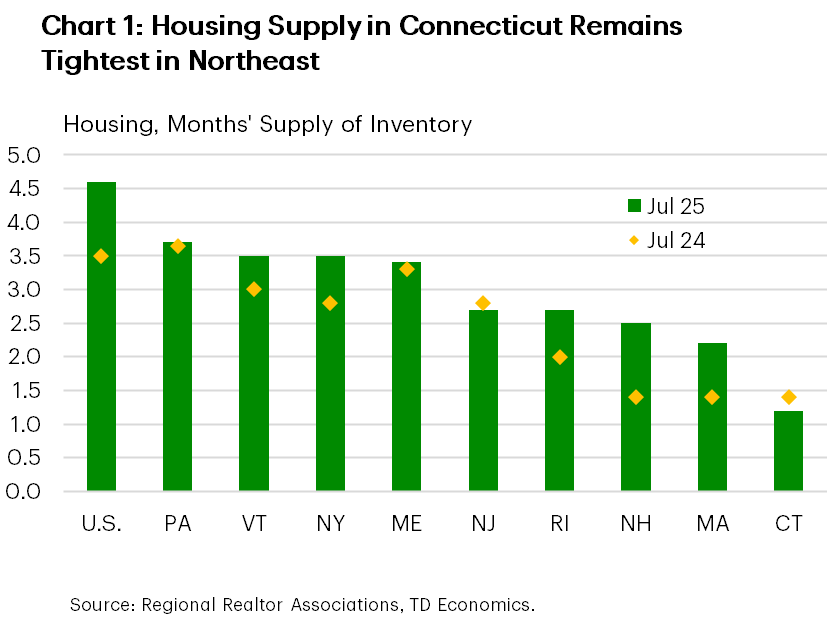
The Connecticut economy remained subdued through the first half of the year but has recently been exhibiting mixed signals amid elevated uncertainty. Activity in the manufacturing and construction sectors has remained soft, although the state's outsized defense sector has provided a partial offset. Many federal defense contracts allow for cost passthrough on tariffs, which combined with higher domestic defense outlays has helped to partially insulate the sector. In addition, the state's outsized white-collar sector has picked up recently. While these are positive developments, we expect aggregate economic growth to soften in 2025 to 1.3% as cyclical headwinds build through the end of the year.
Connecticut's unemployment rate has risen sharply in 2025 but more recently leveled off during the summer. Falling labor force participation has tightened the labor market, which combined with a summer uptick in employment kept the unemployment rate stable. The rate is expected to rise slightly by year-end, leading to an average of 4.2% moving into 2026. However, risks remain, as domestic outflows and slower international inflows could keep the labor market tighter than expected.
Looking at hiring by industry, the financial, professional, and tech sectors boosted Connecticut's employment growth above the national pace over the past three months, as these sectors rebounded from the period of acute trade uncertainty earlier in the year. Layoffs in manufacturing and retail offset some of these gains, with manufacturing still facing notable short-term challenges. However, the large defense industry is set to continue to benefit from federal defense contracts like Pratt & Whitney's recent $2.9 billion F-35 engine deal. Unfortunately, hiring in the large health care sector remains slow compared to other states, which could limit job growth for the rest of the year. With modest economic growth expected, employment is projected to slow to 0.4% in 2025.
Housing price growth in Connecticut has been exceptionally strong over the past year, with prices 6.2% higher year-on-year in July. This has been driven in part by inventory levels which are the lowest in the region (Chart 1). While homebuilding activity has picked up in 2025, it is unlikely to alleviate existing supply shortages. With price growth cooling recently, we expect annual price growth to slow to 3.0% in 2025, before rising to 3.4% next year as supply improves modestly.
Massachusetts: Federal Funding Cuts Slowing Economy
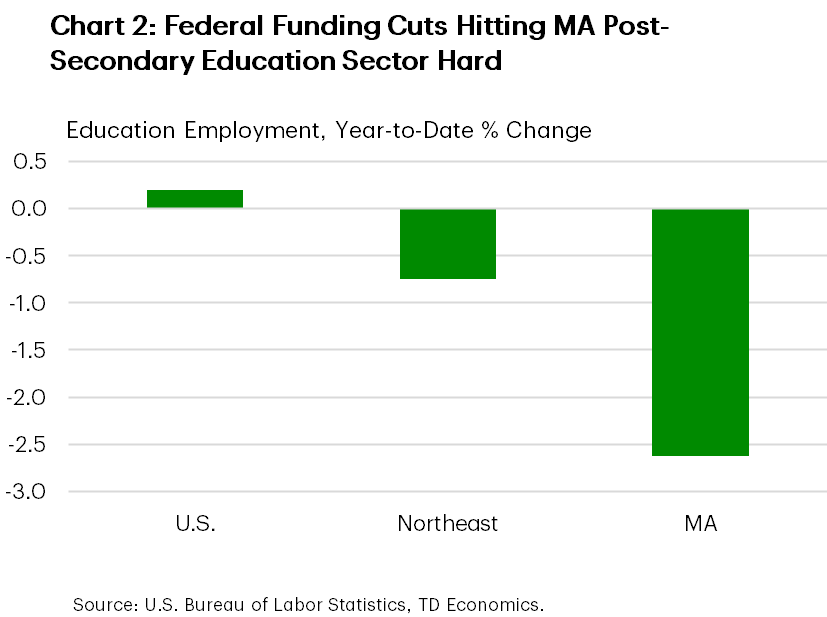
Massachusetts' economy has struggled in 2025 due to tighter financial conditions, federal funding cuts to higher education, and trade policy uncertainty. Segments of the state's large technology sector have benefitted from the boom in artificial intelligence investments, but the overall white-collar sector, which accounts for over half of the state's GDP, has been stagnating. We expect real GDP growth to slow to 1.6% this year, before rebounding to 2.0% in 2026.
An earlier increase in labor force participation that boosted the state's unemployment rate has begun to slow, stabilizing the unemployment rate. This trend was also supported by an uptick in employment growth in the spring, but more recently growth has slowed. Job openings in the state have fallen 8.6% relative to their year-ago level, bringing the ratio of available jobs to unemployed individuals to its lowest level since early 2021. Looking ahead, the unemployment rate is expected to remain elevated over the coming months before declining in 2026 to average 4.3%.
The industry-level picture paints a more concerning picture of the Bay State labor market. Job growth has remained modestly positive due to sustained support from the large health care sector, in addition to recent strength in the smaller construction and transportation & utilities sectors. More concerningly, federal funding cuts have led to layoffs in the post-secondary education sector (Chart 2), with knock on effects to hiring in professional & business services sectors. The post-secondary education sector is also likely to face additional headwinds from reduced international student inflows, which fell to a 4-year low nationally in August. Cumulatively we expect employment growth to remain soft at 0.2% in 2025, before rising to 0.6% next year.
The Bay State housing market has begun to weaken in line with the economic backdrop, with home prices falling in four of the past five months. Prices were up only 3.5% year-on-year in July, marking the lowest reading in two years. Persistent affordability challenges coupled with elevated economic uncertainty have weighed on homebuying. Nevertheless, supply levels are still among the lowest in the region. We expect price growth of 3.5% this year before moderating further to 1.3% in 2026.
New Hampshire, Maine, Vermont: Tourism Woes Weigh on Region
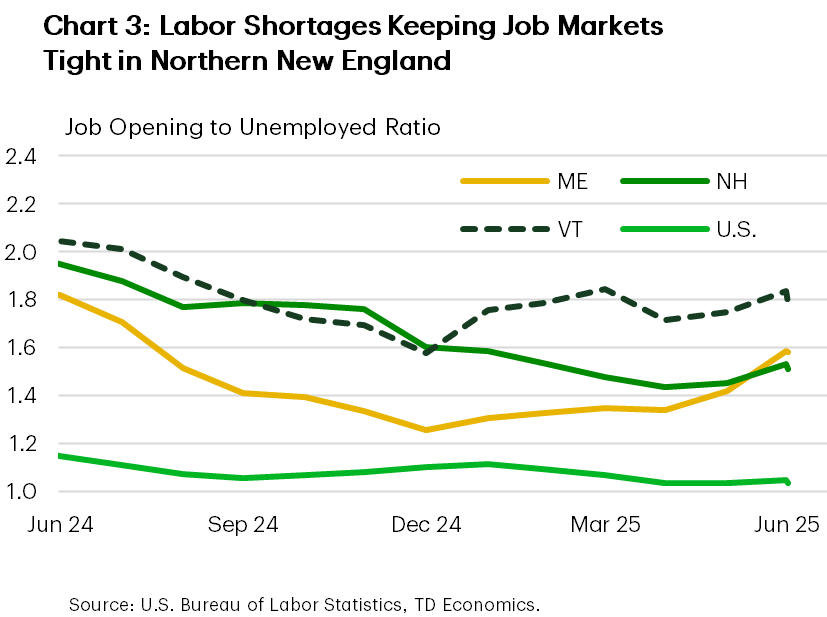
The northern tri-state region of New England saw decelerating economic growth through the first half of the year. Reduced tourism inflows have dented consumer trends in the state, while layoffs in the federal workforce have also weighed on the local economy. These forces are expected to weigh more heavily on Maine and Vermont this year, holding their growth to 1.2%, while New Hampshire fares better at 1.7%, owing to a strong start to the year.
Despite job losses across the region in recent months, labor markets have tightened in all three states due to notable declines in the labor force in Maine and Vermont, while New Hampshire's labor supply has remained unchanged. All three states have seen declines in their labor force participation rates in 2025, likely in part reflecting stricter federal immigration policies and limited domestic migration failing to offset the impact of population aging. These trends have created labor shortages in all 3 states, with the job opening to unemployed ratio rising over the past few months (Chart 3). We expect unemployment rates to fluctuate near current levels through year-end, as soft labor demand is offset by labor supply challenges, before falling modestly in 2026.
The impact of reduced tourist traffic is clear to see in the employment trends, with leisure & hospitality jobs down 1.4% in Maine, 2.8% in New Hampshire, and 0.8% in Vermont over the past three months. International traveler inflows to the region from May through July were down 33% year-on-year according to U.S. Customs & Border Patrol data. In the broader employment market, health care has acted as a stabilizing force. Nevertheless, employment growth is expected to remain relatively weak in 2025, at 0.1% in Maine, 0.7% in New Hampshire, and 0.5% in Vermont.
In concert with the slowing regional economy, house prices in all three states have trended lower since March, matching the trend seen nationally. Declines in Maine and Vermont have been above average during this time, likely in part reflecting the high share of each market accounted for by vacation homes, which are typically more sensitive to economic uncertainty. Housing supply conditions have improved modestly through the first half of the year, but remain tight relative to the nation. Moving forward, expect price growth in 2025 of 2.9% in Maine, 4.7% in New Hampshire, and 3.6% in Vermont as easing demand and rising supply trends continue.
Middle Atlantic (NJ, NY, PA)
New Jersey: Mounting Concerns for Garden State Economy
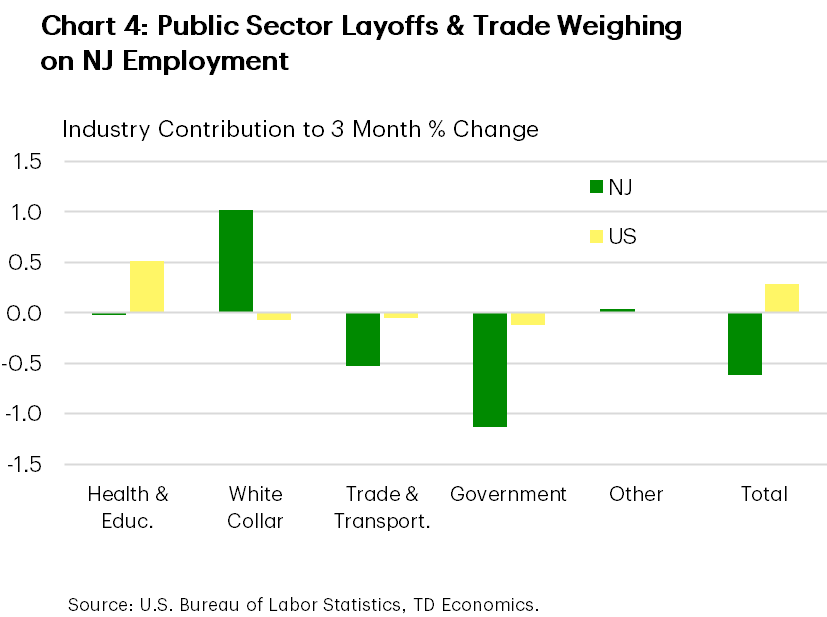
The Garden State economy has seen a modest improvement over the past few months but remains subdued overall. The state's white-collar sector rebounded coming into the second half of the year, but this has been offset by persistent weakness in bellwether sectors of the economy, likely related in part to the state's outsized trade exposure. For 2025, we expect modest economic growth of 1.4%, before a gradual recovery through 2026 boosts growth to 1.5%.
Employment in New Jersey has fallen by nearly 4,000 jobs (or 0.1%) since the start of the year, which has pushed the unemployment rate up to 5% - it's highest level since mid-2016 outside the pandemic period. The increase in the unemployment rate would have been larger had the state's labor force not contracted by 0.3% year-to-date. Overall employment trends remain soft, and we expect the unemployment rate to remain elevated through year-end before trending lower in 2026 to average 4.7%.
New Jersey's large white-collar sector has been one bright spot in the generally weak job market over the past few months. Elsewhere, layoffs in the education sector have been offsetting gains in health care, constraining a key pillar of stability for the state. In addition, all three levels of government have also been reducing payrolls for most of the year, adding another headwind for non-cyclical sources of job growth. Lastly, sectors that are typically more sensitive to the business cycle have been shedding jobs rapidly. This includes construction (-5.9% year-to-date), wholesale trade (-2.7%), and retail trade (-1.6%) (Chart 4). Job growth in 2025 is expected to stay below the national average but outpace the nation in 2026 as economic headwinds gradually subside.
Despite a softening economy over the past year, the Garden State housing market has been all gas no brakes up until recently. July marked the first monthly price decline in seasonally adjusted home prices in five years, but they were still up 6.4% year-on-year (more than double the state's pre-pandemic average). Supply has remained exceptionally tight relative to demand, with the months' supply of inventory roughly half the national average. Moving forward, tight supply conditions are likely to keep the descent in house price growth gradual, with our expectations for 6.2% growth this year followed by 3.5% in 2026.
New York: Elevated Uncertainty Burdening Empire State
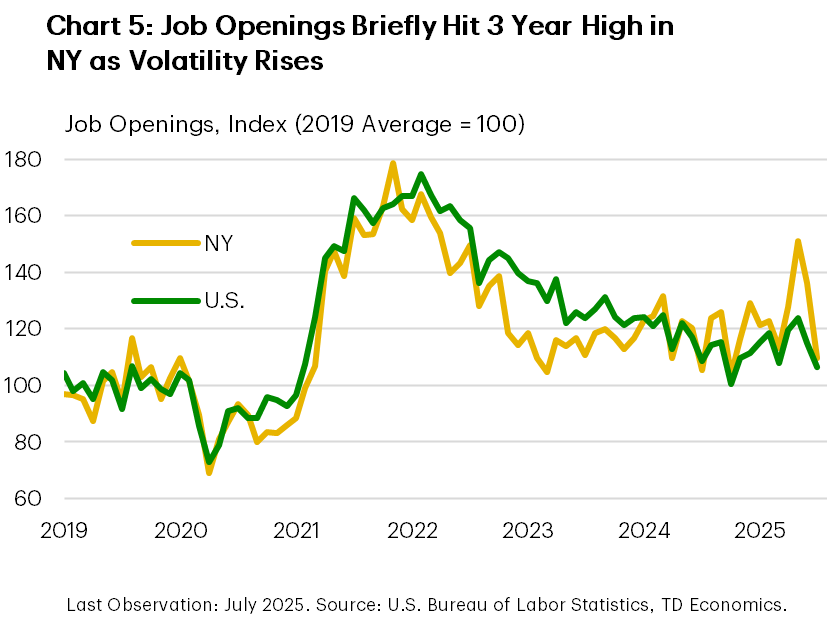
The Empire State economy has slowed in 2025 as elevated uncertainty has weighed on the high-growth financial and technology sectors. However, the state's economy has also continued to benefit from large scale investments in artificial intelligence, which have helped lean against the broader weakness in the economy. Productivity growth stemming from these investments will take time to properly assess, but we expect 2025 real GDP growth to come in at 1.5% amid the broader economic slowdown.
New York's labor market has softened in line with the economy, with job growth in the first half of the year one-fifth of its pace recorded in the year prior. Despite this, the unemployment rate has still drifted gradually lower owing to minimal growth in the state's labor force. More recently, data anomalies have complicated the labor market picture in New York, with an outsized, 18.3% increase in job openings in May (Chart 5) pushing the ratio of job openings to unemployed to a three-year high, although this trend has since been reversed. Beyond this noise, the labor market appears to be in a stable, but slowing state, which we expect to keep the unemployment rate in an elevated range into 2026.
The composition of employment growth this year has been skewed to non-cyclical sectors, pointing to softer private sector demand. The outsized health care sector has accounted for nearly every net new job created in New York this year, similar to the national trend. Additional support has been provided by state & local government, but the post-secondary education sector, continuing to face federal funding cuts, has recorded material layoffs. Several cyclical industries have also seen layoffs, which include the manufacturing, construction, and professional & business services sectors, while most other sectors have been flat so far this year. Employment growth of 0.9% is expected this year, before easing to 0.6% in 2026 as the slowdown through year-end weighs on the new year.
After a resilient start to the year, the Empire State housing market has shifted into lower gear with prices roughly unchanged over the past few months, driven by a multi-year high in supply alongside weaker demand. Given marked affordability challenges, above average price growth in New York was unsustainable, and we expect price growth this year to fall to 3.4% before reaching 1.7% in 2026.
Pennsylvania: Infrastructure Investments Aiding State Amid Cyclical Headwinds
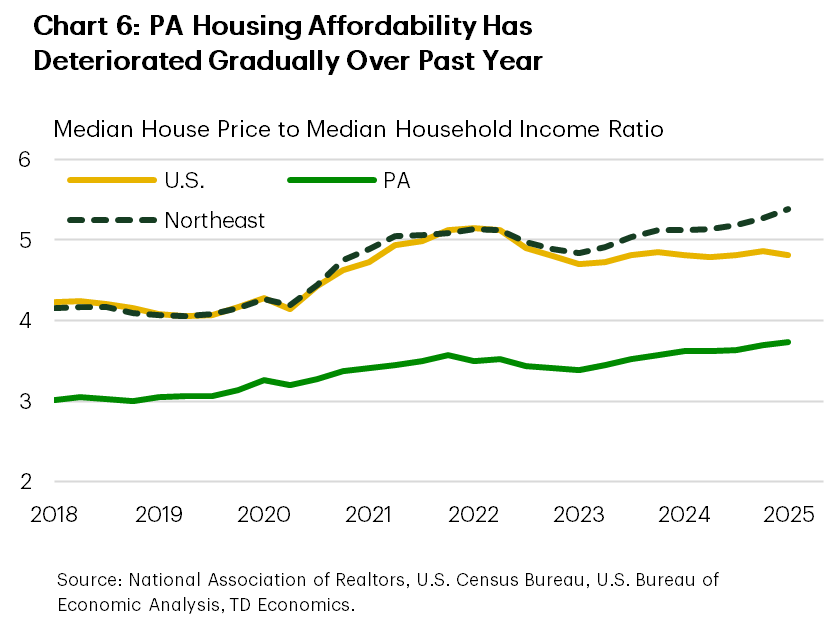
Pennsylvania was the only state in the Northeast to expand in the first quarter of the year, albeit modestly, aided by the outperformances in the large health care sector and resilience in the white-collar sector excluding finance & insurance. The Keystone State has also seen tens of billions of dollars in new utility infrastructure investments announced over the past few months, primarily dedicated to supporting the buildout of data centers in the state. These investments are expected to support the economy through the construction phase over the coming years, but long-term impacts would rely on network economic effects that are seldom guaranteed with digital technologies. Over the near-term, we expect real GDP growth of 1.6% before growth moderates slightly to 1.4% in 2026.
Employment growth in Pennsylvania outpaced the national average through the first half of the year, supported by above average gains in the state's two largest cities, but more recently has converged closer to the nation. This slowdown in job growth has lifted the unemployment rate, which is now back above 4% for the first time in nearly three years. We expect some further upward pressure to be applied to the state's unemployment rate over the coming months, leading it to average 4.3% in 2026.
The health care sector accounted for over half of the job growth recorded year-to-date in Pennsylvania, which combined with modest support from the professional & business services and leisure & hospitality sectors allowed the state to outperform the nation. Most other sectors have seen limited hiring, except for the federal workforce, which has been shedding jobs. Shifting into the second half of the year, with the composition of job growth narrowing, we expect job growth to soften heading into 2026, with annual growth for the year falling to 0.3%.
Pennsylvania's housing affordability advantage has helped to keep price growth above the national average. This remains true, but price growth has converged closer to the nation in 2025, as the state's affordability relative to the nation has returned to pre-pandemic levels (Chart 6). For 2025 we expect price growth of 3.8% before easing to 2.1% in 2026.
Upper South Atlantic (DC, DE, MD, NC, VA, WV)
DC-Maryland-Virginia (DMV): Federal Government Cutbacks Continue to Weigh on Region
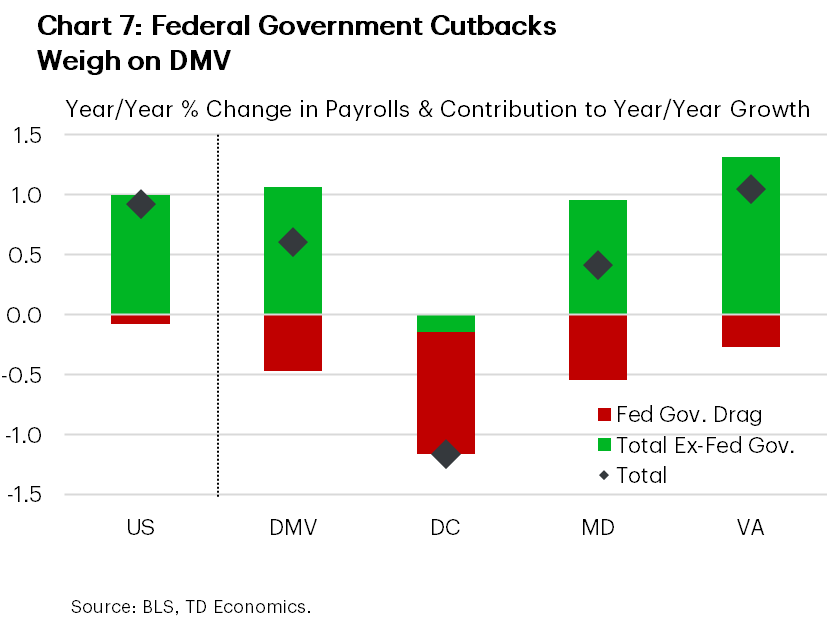
Economic activity in the region made up by DC, Maryland (Md.) and Virginia (Va.) – the DMV – is slowing. Cuts to federal employment stemming from DOGE efforts continue to weigh heavily on the region (Chart 7). Payrolls growth has eased to 0.6% y/y annualized, with DC continuing to shed jobs, Md. remaining in the slow lane, and Va. keeping pace with the nation. DC's unemployment rate has surged to 6% recently – the highest level nationwide. The weakness in DC is broad-based, with most sectors outside of accommodation having shed workers so far this year. Md. and Va. have had a better mix of drivers, with educational services in Md., construction in Va., and healthcare and state & local government in both, providing additional support. This, combined with the fact that Md.'s and Va.'s labor force have been trekking lower recently, has helped keep their unemployment rates well below the national level at 3.6%.
Despite existing headwinds, the regional labor market still has some gas in the tank. This is evident in job openings-to-unemployed worker ratios that remain somewhat higher across all three compared to the national average. The fact that company expansions in the region continue, adds credence to this view, with firms like IronCircle (cybersecurity), Syngene International (life sciences), X-energy (nuclear) poised to generate 1000 jobs combined in Md. In nearby Va., Eli Lilly's $5B pharmaceutical facility will support 1800 construction jobs and 650 permanent manufacturing jobs, while investments from Hitachi Energy (power transformer production facility) and Amazon (automated fulfillment center) will generate over 1800 jobs combined.
Looking ahead, the major disruption in the federal government sector is poised subside in time, and as that drag eases, the regional economy should find better footing. Additionally, plans to boost federal defense spending could yield some benefit for Md. and Va. – both of which punch well above their weight when it comes to defense dollars (see here). Finally, lower interest rates ahead should lend a hand to consumer related industries, including housing. Home prices continue to trail lower in DC, but have also headed lower in Md. and Va. more recently, even as inventory metrics in these latter two suggest they remain in a seller's market. Lower rates will help bring back more buyers to the regional housing market, with improved activity a tailwind for real estate & leasing. The construction sector should benefit from this trend too, with an improved residential construction backdrop over the medium term poised to play a role in keeping housing affordability from deteriorating much further.
All told, the DMV economy is on track to experience slower growth this year, with DC expected to grow at only 0.9%, Md. at 1.6% and Va. at 1.9%. Activity in the region should improve gradually as the next year unfolds, but a slow starting point will likely keep annual growth rates near this year's levels.
North Carolina: Moderating Pace, but Still-solid Fundamentals

The Tar Heel State economy continues to outperform most of its peers, but signs of a maturing cycle are becoming more evident. Following several years of rapid expansion, growth has moderated across key indicators. Job creation has slowed notably in recent months, home price growth has dipped into shallow negative territory, and exports are also trending lower. Despite the broader cooling, the state's underlying fundamentals remain solid, with decent population growth and an unemployment rate that remains near recent cyclical lows.
North Carolina remains a magnet for manufacturing investment. Expansions from firms such as JetZero (aircraft, $4.7B investment leading to 14,500 jobs), Eco King Solutions (paper tableware, $80M, 500 jobs), Prolec GE Waukesha (power transformers, $140M, 300+ jobs), underscore the state's appeal. These expansions are emblematic of an ongoing wave of capital-heavy projects. But their impact on sectoral employment may be more muted than in previous cycles given the tilt toward automation and high-tech infrastructure.
Thankfully, North Carolina's labor market has plenty of drivers, and unlike nationwide, there are still plenty of open positions across the state (Chart 8). Ongoing expansions in other areas of the economy reinforce the notion that the state's labor market has a bit more gas in the tank. For instance, Amazon Web Services plans to invest $10B to launch a new high-tech cloud computing and AI innovation campus in Richmond County, leading to 500 jobs. At the same time, Citigroup will invest $16M in a new tech hub in Charlotte, leading to over 500 jobs, while BuildOps (software) will establish a new hub in Raleigh, creating 300 jobs.
The housing market, meanwhile, remains in the slow lane amidst an elevated interest rate environment. Home sales were down 6% y/y in August. Meanwhile, prices have been trending lower recently as per the CoreLogic measure. This has partly to do with looser market conditions, with the month's supply of inventory at 5.7 in August (vs. 4.3 nationwide). Mortgage rates dropped noticeably in September, and expectations for even lower rates next year should help reinvigorate demand and breathe new life into this and other consumer-facing sectors.
All told, we anticipate the North Carolina economy to grow by 2.1% this year (from 3.7% in 2024), and 2.0% in 2026.
Lower South Atlantic (SC, GA, FL)
South Carolina: Still the Leader

South Carolina is expected to lead the East Coast in growth again this year with GDP projected to expand by 2.5%. The state's hiring rates continue to outperform regional and national trends. While trade risks remain due to the state's high exposure to trade, they have not significantly impacted the economy so far.
The Palmetto State's job market has also been outperforming. Job growth has improved, rising to 3% (y/y) – the best showing nationwide. Gains have been well-diversified across industries, including professional & business services, leisure & hospitality, financial activities, and healthcare. It's worth noting that while healthcare has played an outsized role nationally and regionally, its contribution to job gains in South Carolina over the past year is overshadowed by other drivers (Chart 9). The state's unemployment rate had flatlined at a little over 4% for most of this year amidst improving job growth, but ticked up to 4.3% in August. The ratio of job openings to unemployed workers has eased recently – suggesting that hiring will shift into a lower gear, while the unemployment rate will trek a bit higher.
South Carolina continues to attract plenty of investment, especially on the manufacturing front, but recent expansions have been generally smaller in scale compared to other high-profile announcements made in previous quarters. A few noteworthy examples include expansions from Woodward (aerospace related, 275 jobs), FabLogix (pipe fabrication, 150 jobs), ATP (adhesives, 130 jobs), SCHNEEBERGER (linear tech, 100 jobs), ATI (aerospace, 70 jobs), and Rolls-Royce (engines, 60 jobs). The success of the manufacturing sector is partly rooted in trade, with the state exporting $38B worth of goods last year – about half of that being transportation equipment (both autos and aerospace). Product-specific tariffs, such as those on steel and aluminum, may raise the costs for some of these products, but recent trade deals have been encouraging. Provided that more such deals – that largely avoid counter-tariffs on American-made goods – are reached, the risks surrounding export-related sectors would subside further.
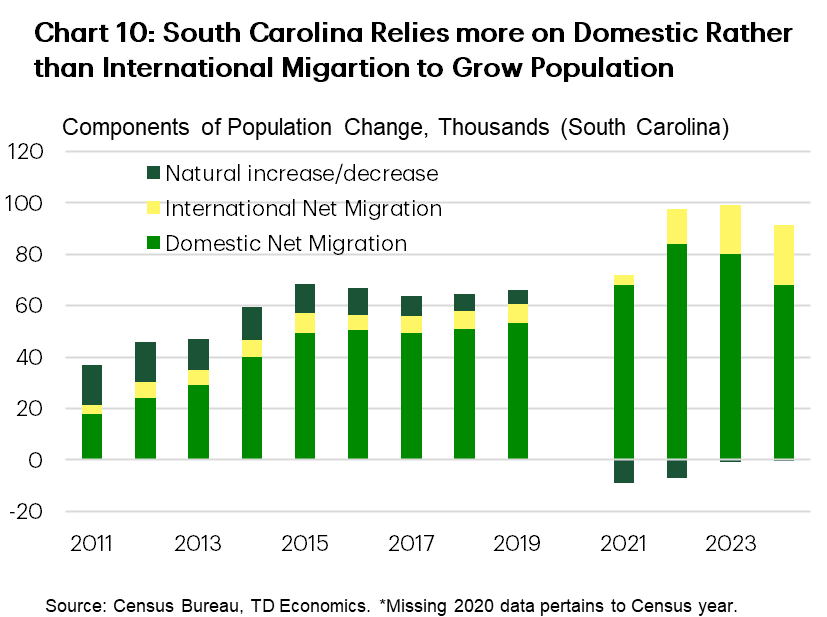
South Carolina's consumer channel is poised to offer additional support, especially with interest rates heading lower. To this end, the recent weakness in home price growth should prove temporary, with lower mortgage rates poised to help reinvigorate housing demand. We anticipate home prices will trek gradually higher over the next two years, with home price growth forecast at 1.4% in 2025 and 3.7% in 2027.
Additionally, the state relies more on domestic, rather than international migration to grow its population (Chart 10). As such, the downdraft in population growth from more restrictive immigration policy should be more muted. We anticipate population growth to ease from 1.7% last year to a little over 1% over the medium term. South Carolina's diverse economy combined with healthy population growth, will continue to bolster demand for all kinds of professional and business services – extending the sector's positive growth trajectory. Overall economic activity should improve gradually as the next year unfolds, even as the slower momentum at the turn of 2026 will weigh on the annual growth profile, likely keeping it at 2.1% – which is still a few ticks above the national rate.
Georgia: Healthcare to the Rescue
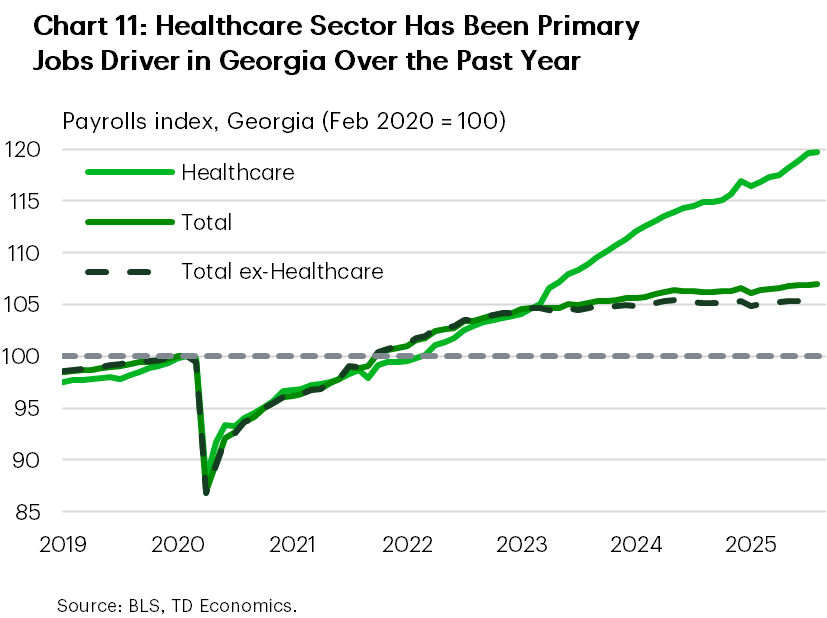
Georgia’s economic momentum has cooled in 2025 and looks to be moving broadly in line with the national trend. After a sluggish start to the year, job growth has picked up modestly, but gains remain uneven across sectors. Healthcare has been the primary engine of employment growth, keeping the state’s labor market afloat while other industries – particularly logistics, retail, and wholesale trade – have faced headwinds (Chart 11). Despite these challenges, Georgia’s unemployment rate has remained low thanks in part to a shrinking labor force, likely influenced by softer migration trends.
Other signs of resilience in the labor market include job openings, which remain elevated, with approximately 1.5 positions available for every unemployed worker – well above the national average. This suggests that hiring momentum has a bit more runway ahead. Ongoing corporate investments further bolster this theme. Recent notable announcements include a new $223M rare earth magnet facility from JS Links America, a $275M facility by EnergyTek (renewable energy components), a $400M prepared foods facility by Pilgrim's, and a new pediatric medical research center by Shriners Children’s in Atlanta. These projects span a range of industries and should lead to roughly 3000 jobs ahead, offering a lift to the state’s employment outlook.
Looking at the different sectors, Georgia’s outsized logistics industry faces some near-term turbulence. While long-term investments at the Ports of Brunswick and Savannah remain promising, recent tariff-related disruptions have dampened activity. Container volume at the Port of Savannah has eased since the spring, when businesses rushed to front-load shipments ahead of tariff hikes. This soft patch may persist over the near-term, until more meaningful trade agreements are reached. Georgia’s high-tech ecosystem, meanwhile, should also offer some support. The state’s emerging electric vehicle (EV) cluster and surging demand for data centers are fueling growth in professional and business services. After two years of contraction, hiring in this sector has trended moderately higher this year. A notable development is Rivian ’s plan to open its East Coast headquarters in Atlanta, which should employ 500 workers once fully built. Construction of its $5B EV plant is expected to restart later this year, with production slated for 2028.
On the housing front, the market has softened somewhat, with inventory having risen to 4.7 months’ supply, up from 3.8 a year ago. Home prices and apartment rents are falling slightly, reflecting a cooling market. However, lower interest rates should help reinvigorate demand, supporting both home sales and residential construction activity.
In summary, Georgia’s economy is navigating a period of moderation, with projected growth of around 2% over 2025-26 – down from 3.4% in 2024, but broadly in line with the national pace.
Florida: Strength Gives Way to Moderation
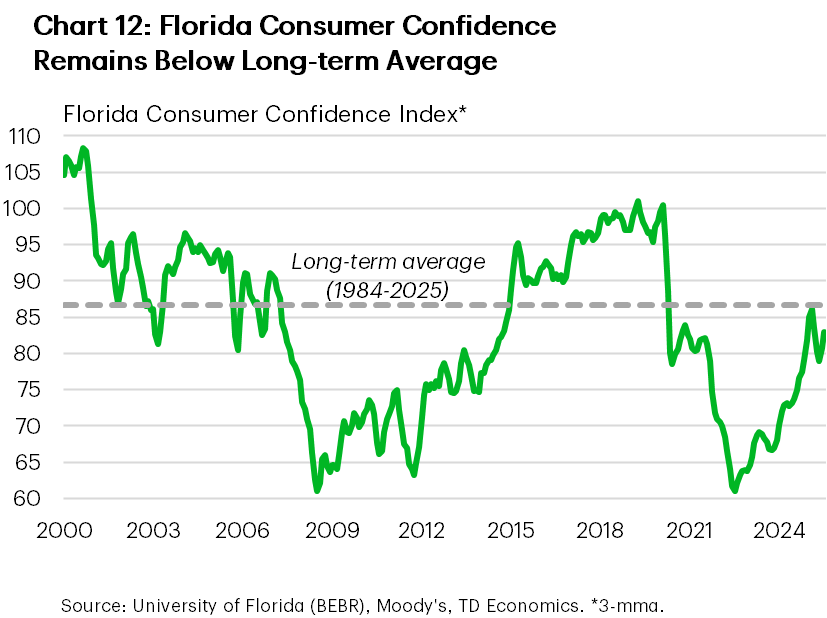
After several years of robust expansion, Florida’s economy has moderated. Recent data signals a broad slowdown in activity, led by ongoing housing market challenges and weaker migration inflows. Still, the state retains key growth drivers and is expected to keep a modest edge over the nation over the next two years.
Payrolls growth has stalled, with sectors like leisure and hospitality, professional & business services, manufacturing, and construction shedding jobs recently. Gains in local government, education & healthcare, and logistics have helped offset losses, keeping overall job growth from dipping further into negative territory. Despite the hiring weakness, a slowdown in labor force growth has moderated the upward path in the state's unemployment rate, which stood at 3.5% at the start of the year and rose to only 3.8% by August.
International migration buoyed population and labor force growth last year, as domestic inflows waned. However, tighter immigration policy is now curbing that support. Florida also has the highest share of undocumented immigrants of any state at 7% of the population (and 9% of the labor force) in 2023. This segment of the population is likely scaling back spending due to uncertainty, weighing on consumption activity at the margin. Overall consumer confidence in the state has recovered from its spring lows, but remains below historical norms (Chart 12). Additionally, there are signs that tourism is not providing the same 'oomph' it once did. Domestic visits have flatlined, while international visits have pulled back a little recently, featuring a sharp drop in visits from Canada. A weaker consumer backdrop over the next few quarters (see report) is likely to further strain the state’s vital leisure & hospitality sector over the near-term.
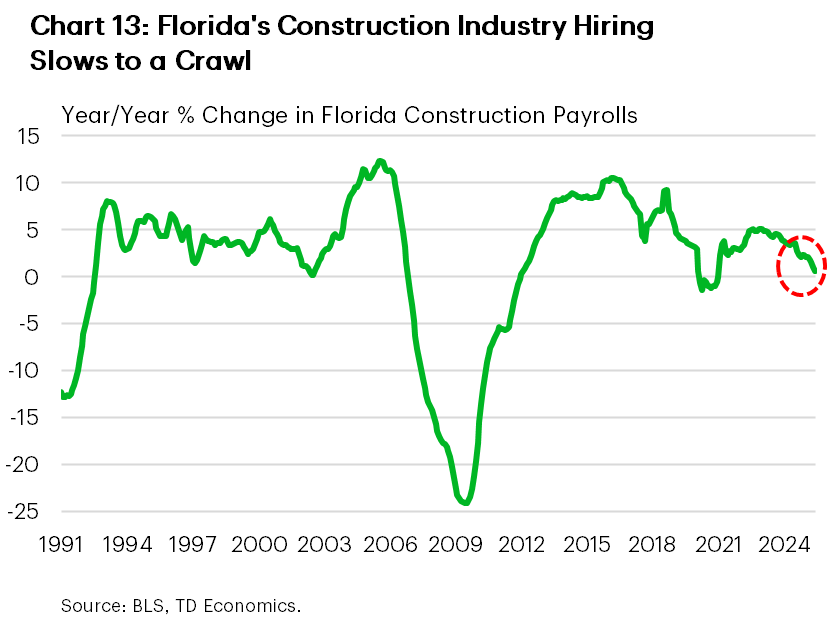
Tighter immigration policy is also making it harder for some businesses to source workers, especially in sectors that are more likely to employ undocumented workers, such as agriculture and construction. Payroll growth in the latter has effectively flatlined over the past year (Chart 13). This trend reflects in part the state's ongoing housing market weakness.
Home sales remain sluggish, down 5% year-to-date, with condos seeing a steeper 12% decline. Prices reflect similar trends, with the condo segment weighing on the broader market. Employment in Florida's real estate & leasing industry has held its own so far, having recorded some gains recently, but sustained growth will be difficult if current conditions persist. Fortunately, lower borrowing costs should offer relief to Florida’s sizable housing sector, even as the condo market will take longer to rebound (see here).
For all the headwinds curtailing the growth of the Sunshine State, there appears to be more gas in the tank. Business investments continue, with notable expansions in manufacturing from firms like Boeing, Danone, Williams International, Point Blank Enterprises, and Global Impact Products – expected to add a combined 1,400 jobs ahead. Additionally, the construction of several large hospitals across the state signals ongoing momentum in the healthcare sector, a consistent growth engine.
All in all, we anticipate the Florida economy to grow at 2.3% this year and 2.1% next – a performance that continues to best the nation, albeit by a more modest margin than in recent years.
Tables
TD State Forecasts
| States | Real GDP (% Chg.) |
Employment (% Chg.) |
Unemployment Rate (Average, %) |
Home Prices (% Chg.) |
Population (% Chg.) |
||||||||||
| 2025F | 2026F | 2027F | 2025F | 2026F | 2027F | 2025F | 2026F | 2027F | 2025F | 2026F | 2027F | 2025F | 2026F | 2027F | |
| National | 1.8 | 1.8 | 2.2 | 0.9 | 0.4 | 0.7 | 4.2 | 4.2 | 4.0 | -0.7 | 1.1 | 3.5 | 0.5 | 0.3 | 0.3 |
| New England | 1.5 | 1.6 | 1.8 | 0.3 | 0.4 | 0.5 | 4.1 | 4.0 | 3.6 | 4.4 | 2.0 | 2.9 | 0.3 | 0.2 | 0.3 |
| Connecticut | 1.3 | 1.2 | 1.5 | 0.4 | 0.2 | 0.3 | 3.8 | 4.2 | 4.1 | 7.0 | 3.0 | 3.4 | 0.2 | 0.1 | 0.2 |
| Massachusetts | 1.6 | 2.0 | 2.1 | 0.2 | 0.6 | 0.7 | 4.7 | 4.3 | 3.5 | 3.5 | 1.3 | 2.8 | 0.4 | 0.3 | 0.3 |
| Maine | 1.2 | 1.3 | 1.4 | 0.1 | 0.4 | 0.2 | 3.4 | 3.4 | 3.1 | 2.9 | 2.0 | 3.2 | 0.3 | 0.2 | 0.3 |
| New Hampshire | 1.7 | 1.5 | 1.9 | 0.7 | 0.4 | 0.5 | 3.1 | 3.1 | 2.8 | 4.7 | 2.2 | 2.7 | 0.3 | 0.2 | 0.3 |
| Rhode Island | 1.3 | 1.1 | 1.2 | 0.4 | 0.3 | 0.4 | 4.8 | 4.5 | 4.1 | 6.2 | 3.1 | 2.9 | 0.2 | 0.1 | 0.2 |
| Vermont | 1.2 | 1.0 | 1.1 | 0.5 | 0.2 | 0.4 | 2.7 | 2.8 | 2.6 | 3.6 | 2.0 | 2.8 | 0.0 | 0.1 | 0.1 |
| Middle Atlantic | 1.5 | 1.6 | 1.6 | 0.9 | 0.5 | 0.6 | 4.3 | 4.4 | 4.3 | 4.2 | 2.2 | 2.8 | 0.1 | 0.1 | 0.1 |
| New Jersey | 1.4 | 1.5 | 1.7 | 0.6 | 0.5 | 0.7 | 4.8 | 4.7 | 4.3 | 6.2 | 3.5 | 3.1 | 0.3 | 0.3 | 0.4 |
| New York | 1.5 | 1.7 | 1.6 | 0.9 | 0.6 | 0.5 | 4.2 | 4.4 | 4.3 | 3.4 | 1.7 | 2.6 | 0.0 | 0.0 | -0.1 |
| Pennsylvania | 1.6 | 1.4 | 1.6 | 1.2 | 0.3 | 0.6 | 4.0 | 4.3 | 4.2 | 3.8 | 2.1 | 2.8 | 0.2 | 0.1 | 0.1 |
| Upper South Atlantic | 1.8 | 1.7 | 2.0 | 0.9 | 0.6 | 0.9 | 3.6 | 3.8 | 3.5 | 2.5 | 1.4 | 3.3 | 0.6 | 0.5 | 0.7 |
| District of Columbia | 0.9 | 1.1 | 1.3 | -0.4 | 0.2 | 0.3 | 5.9 | 5.9 | 5.4 | -1.5 | 0.6 | 2.4 | 0.3 | 0.2 | 0.3 |
| Delaware | 1.6 | 1.1 | 1.5 | 0.9 | 0.6 | 0.7 | 4.0 | 4.3 | 4.2 | 2.2 | 1.2 | 3.0 | 0.7 | 0.6 | 0.9 |
| Maryland | 1.6 | 1.5 | 1.8 | 0.6 | 0.4 | 0.6 | 3.2 | 3.2 | 2.9 | 2.3 | 1.3 | 3.2 | 0.4 | 0.3 | 0.3 |
| North Carolina | 2.1 | 2.0 | 2.3 | 1.4 | 0.8 | 1.2 | 3.8 | 4.0 | 3.8 | 2.0 | 1.4 | 3.5 | 1.0 | 0.9 | 1.1 |
| Virginia | 1.9 | 1.8 | 2.2 | 0.9 | 0.5 | 0.9 | 3.4 | 3.5 | 3.2 | 3.1 | 1.5 | 3.5 | 0.5 | 0.4 | 0.6 |
| West Virginia | 1.3 | 1.2 | 1.3 | 0.1 | 0.2 | 0.2 | 3.9 | 4.5 | 4.4 | 4.9 | 1.7 | 2.6 | -0.2 | -0.2 | -0.2 |
| Lower South Atlantic | 2.2 | 2.0 | 2.4 | 1.3 | 0.9 | 1.4 | 3.8 | 4.0 | 3.7 | -0.1 | 0.5 | 3.3 | 1.1 | 1.0 | 1.2 |
| Florida | 2.3 | 2.1 | 2.6 | 1.4 | 0.9 | 1.5 | 3.8 | 4.0 | 3.7 | -1.3 | 0.0 | 3.3 | 1.2 | 1.1 | 1.3 |
| Georgia | 2.0 | 1.9 | 2.1 | 0.5 | 0.7 | 1.1 | 3.6 | 3.9 | 3.7 | 1.8 | 1.2 | 3.2 | 0.8 | 0.8 | 0.9 |
| South Carolina | 2.5 | 2.1 | 2.5 | 2.5 | 1.3 | 1.5 | 4.2 | 4.1 | 3.8 | 2.7 | 1.4 | 3.7 | 1.1 | 1.0 | 1.2 |
For any media enquiries please contact Oriana Kobelak at 416-982-8061
Disclaimer
This report is provided by TD Economics. It is for informational and educational purposes only as of the date of writing, and may not be appropriate for other purposes. The views and opinions expressed may change at any time based on market or other conditions and may not come to pass. This material is not intended to be relied upon as investment advice or recommendations, does not constitute a solicitation to buy or sell securities and should not be considered specific legal, investment or tax advice. The report does not provide material information about the business and affairs of TD Bank Group and the members of TD Economics are not spokespersons for TD Bank Group with respect to its business and affairs. The information contained in this report has been drawn from sources believed to be reliable, but is not guaranteed to be accurate or complete. This report contains economic analysis and views, including about future economic and financial markets performance. These are based on certain assumptions and other factors, and are subject to inherent risks and uncertainties. The actual outcome may be materially different. The Toronto-Dominion Bank and its affiliates and related entities that comprise the TD Bank Group are not liable for any errors or omissions in the information, analysis or views contained in this report, or for any loss or damage suffered.